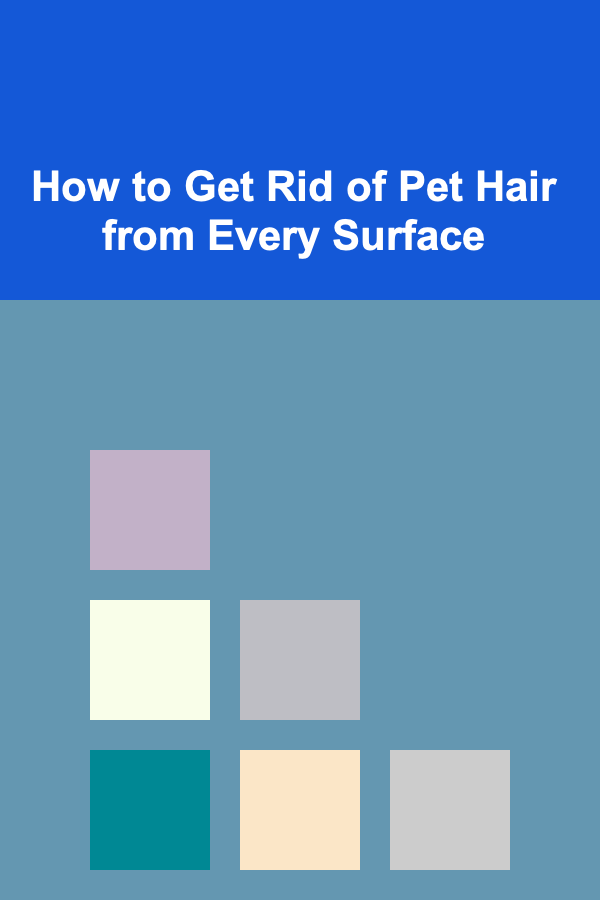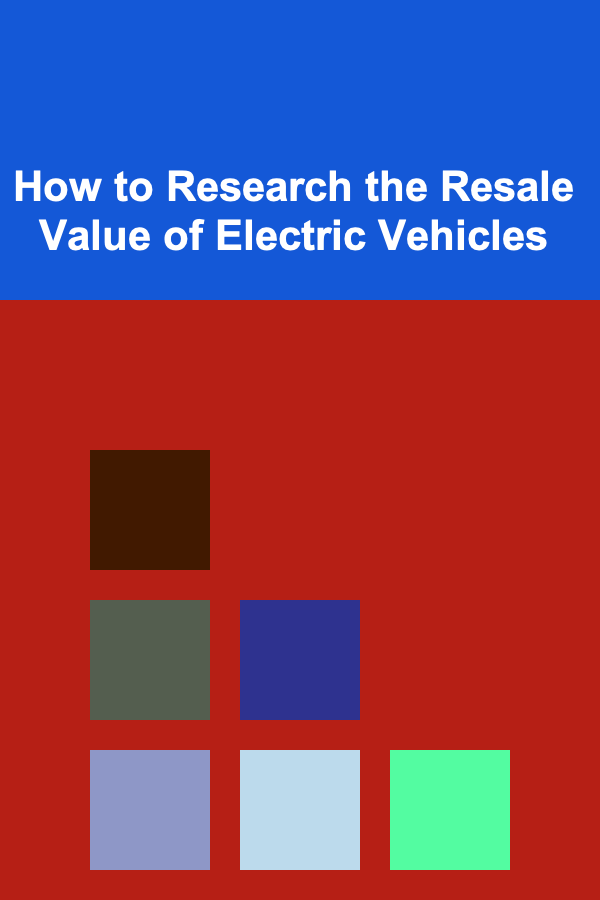
How to Get Rid of Pet Hair from Every Surface
ebook include PDF & Audio bundle (Micro Guide)
$12.99$9.99
Limited Time Offer! Order within the next:

Pets are some of the most cherished companions, bringing joy, love, and a sense of comfort to our homes. However, one of the biggest downsides of having pets, especially those with long or shedding coats, is dealing with the constant accumulation of pet hair. Whether it's on furniture, clothing, or even floors, pet hair can be persistent and challenging to remove. If left unchecked, it can lead to allergies, clogs, and a less than clean living environment.
The good news is that there are many effective strategies and tools available to tackle this issue, and with some dedication, it's possible to keep your home clean and pet-hair free. In this comprehensive guide, we will explore different techniques, tools, and preventative measures to help you get rid of pet hair from every surface in your home. Whether you're dealing with a dog, cat, or any other furry companion, this article will provide you with expert advice to make your life easier and your home cleaner.
Understanding the Problem: Why Pet Hair is So Persistent
Before diving into the solutions, it's important to understand why pet hair is so difficult to deal with. Pet hair is often finer and more lightweight than human hair, which means it can easily float around and settle on various surfaces. Additionally, pets with thick fur or long coats tend to shed their hair frequently, especially during seasonal changes like spring and fall. Some breeds are more prone to shedding than others, but almost all pets lose some hair at different times.
Pet hair also clings to fabric and other surfaces more readily than other types of debris. This is partly due to the shape and texture of the individual hairs. Pet hair has microscopic barbs that cause it to become entangled in fabrics, upholstery, carpets, and rugs. This makes it harder to remove and requires a bit more effort than just vacuuming or sweeping.
Impact of Pet Hair on Health and Hygiene
Pet hair can contribute to various health problems, particularly for those with allergies or respiratory conditions. Pet dander, which consists of tiny particles of skin shed by animals, is a major allergen for many people. When combined with pet hair, this can lead to itchy eyes, sneezing, asthma flare-ups, and other allergic reactions.
In addition to health concerns, pet hair can also impact the cleanliness of your home. Hair can clog vacuum cleaners and air filters, reduce the effectiveness of cleaning appliances, and even create a sticky residue on surfaces if not cleaned regularly.
Effective Tools for Removing Pet Hair
There are several tools and products that can help in removing pet hair from various surfaces. Here are some of the most effective ones:
1. Lint Rollers
Lint rollers are one of the most convenient and popular tools for removing pet hair from clothing, furniture, and other surfaces. They consist of a handle with a sticky sheet that picks up hair when rolled over a surface. Lint rollers are compact and easy to use, making them a go-to choice for quick clean-ups.
- How to use: Roll the lint roller over the surface where pet hair is present, applying light pressure to ensure the hair sticks to the sheet. Once the sheet is full, peel it off and discard it. Some lint rollers come with reusable sheets, which can be washed and reused.
- Best for: Clothing, furniture, and small surfaces. Ideal for quick touch-ups.
2. Rubber Gloves
Rubber gloves, especially those designed for pet hair removal, can work wonders on furniture, upholstery, and even carpets. The rubber material creates static electricity, which attracts pet hair, making it easier to remove from fabrics.
- How to use: Wear the rubber gloves and rub your hands over the surface where pet hair is located. You'll see the hair ball up as you go along, making it easy to pick up and remove. Afterward, you can wash the gloves and reuse them.
- Best for: Furniture, car seats, and carpets. Ideal for larger areas that require a bit more elbow grease.
3. Vacuum Cleaners with Specialized Attachments
A powerful vacuum cleaner is essential when it comes to tackling pet hair on carpets, rugs, and other large surfaces. Many vacuums now come with specialized attachments for pet hair removal, such as motorized brush heads or pet-specific nozzles.
- How to use: Attach the pet hair attachment to your vacuum and run it over the surface. These attachments are designed to lift and capture pet hair more effectively than regular vacuum heads.
- Best for: Carpets, rugs, and large areas. Ideal for heavy shedding areas, such as pet beds and high-traffic zones.
4. Pet Hair Removal Brushes
Pet hair removal brushes are specifically designed to remove stubborn hair from various surfaces. They typically feature a combination of soft bristles or rubber teeth that are effective at pulling hair out of fabric fibers.
- How to use: Gently brush the surface where pet hair is present. Depending on the design, you may need to use different angles or motions to effectively lift and remove the hair.
- Best for: Upholstery, cushions, and delicate fabrics. Ideal for light to moderate shedding areas.
5. Pet Hair Removal Products (Sprays, Powders, and Foam)
Some pet owners prefer using special sprays, powders, or foams designed to loosen pet hair from surfaces. These products work by breaking the bond between the pet hair and fabric, making it easier to vacuum or brush off.
- How to use: Follow the instructions on the product label. Typically, you'll spray or apply the product onto the surface, wait for a few minutes, and then remove the hair with a vacuum or brush.
- Best for: Upholstery, carpets, and bedding. Ideal for deep-cleaning or heavily-soiled areas.
6. Air Purifiers with HEPA Filters
Although not a direct tool for removing pet hair from surfaces, air purifiers with HEPA filters can help reduce pet dander and hair in the air. These devices trap airborne particles, including pet hair, which prevents them from settling on surfaces.
- How to use: Place the air purifier in the rooms where your pets spend the most time. Run it continuously or for several hours per day to reduce pet hair in the air.
- Best for: Bedrooms, living rooms, and any area where your pet spends a significant amount of time.
Removing Pet Hair from Specific Surfaces
Now that we've covered the best tools for removing pet hair, let's dive into specific surfaces and how to effectively clean them.
1. Furniture (Sofas, Chairs, and Cushions)
Pet hair often sticks to furniture, especially upholstered pieces like sofas, armchairs, and cushions. The fabric fibers trap the hair, making it difficult to remove. Here's how you can clean these surfaces:
- Vacuum: Use a vacuum with a brush attachment to remove hair from fabric surfaces. Move slowly and methodically to ensure you remove as much hair as possible.
- Lint Roller: For smaller clean-ups, a lint roller can be an effective tool to quickly pick up hair from upholstery.
- Rubber Gloves: Wear rubber gloves and rub them over the surface. The static created will help lift the pet hair off the fabric.
- Pet Hair Removal Brushes: Use a specialized pet hair removal brush to loosen stubborn hair.
2. Carpet and Rugs
Carpets and rugs are often the most difficult surfaces to clean, as pet hair gets embedded deep within the fibers. Here's how to remove pet hair from carpets:
- Vacuum: Invest in a vacuum with a rotating brush or pet hair attachment. Vacuum in multiple directions to loosen and capture hair from different angles.
- Rubber Broom: A rubber broom is great for loosening and gathering pet hair from carpets. Run it over the surface, and the rubber bristles will pull the hair out.
- Pet Hair Removal Tool: Use a specialized pet hair tool for carpets to comb through the fibers and lift the hair.
3. Clothing and Bedding
Pet hair on clothes and bedding can be especially annoying, but there are ways to tackle it effectively:
- Lint Roller: For clothes, the lint roller is a quick and easy tool to remove pet hair. Roll it over the fabric, applying pressure as you go.
- Dryer Sheets: Toss your clothes or bedding in the dryer with a dryer sheet for 10-15 minutes on a low heat setting. The static created will help remove pet hair.
- Washing: Wash clothes and bedding with a pet hair remover ball or use a lint trap in the washer to catch excess hair.
- Rubber Gloves: Use rubber gloves to remove pet hair from bedding by gently rubbing them over the fabric.
4. Hard Surfaces (Floors, Tables, and Counters)
Pet hair tends to accumulate on hard surfaces like floors, tables, and counters, especially if you have a shedding pet.
- Broom and Dustpan: For floors, use a broom with soft bristles to gather the hair. Sweep it into a dustpan and dispose of it.
- Vacuum: Use a vacuum with a hard floor setting to remove pet hair from tile, wood, or laminate floors.
- Microfiber Cloth: A damp microfiber cloth can be effective at wiping down counters, tables, and other hard surfaces, trapping pet hair as you clean.
Preventing Pet Hair Buildup
Prevention is key to reducing the amount of pet hair you need to clean. Here are some tips to minimize hair accumulation:
- Regular Grooming: Brush your pet regularly to remove loose hair before it has a chance to fall off and spread throughout your home. The frequency of grooming will depend on your pet's breed and coat type.
- Cover Furniture: Use pet covers or throws on furniture to protect it from pet hair. Wash them regularly to keep them free of hair.
- Use Air Purifiers: As mentioned earlier, air purifiers with HEPA filters can help reduce airborne pet hair and dander.
- Clean Your Pet's Bed: Regularly wash your pet's bedding and use a pet-specific mattress protector to reduce hair buildup.
Conclusion
While removing pet hair from every surface in your home can seem like an endless task, the right tools and techniques can make the process much more manageable. By using specialized vacuum attachments, lint rollers, rubber gloves, and pet hair removal brushes, you can keep your home clean and free of pet hair. Additionally, regular grooming and preventative measures can help reduce shedding and make cleaning easier.
With some effort and the right approach, you can enjoy a pet-friendly, hair-free home, allowing you to spend more time enjoying your furry companion and less time cleaning.

Frugal Living Tips: How to Live Well on a Tight Budget
Read More
How to Create a Festive Foyer with Simple Holiday Decorations
Read More
How to Invest in Index Funds for Long-Term Growth
Read More
How to Invest in Startups and Angel Funding
Read More
How to Research the Resale Value of Electric Vehicles
Read More
Mastering Customer Service: Essential Skills for the Modern Customer Service Representative
Read MoreOther Products

Frugal Living Tips: How to Live Well on a Tight Budget
Read More
How to Create a Festive Foyer with Simple Holiday Decorations
Read More
How to Invest in Index Funds for Long-Term Growth
Read More
How to Invest in Startups and Angel Funding
Read More
How to Research the Resale Value of Electric Vehicles
Read More